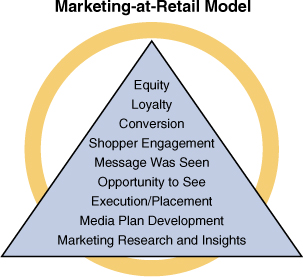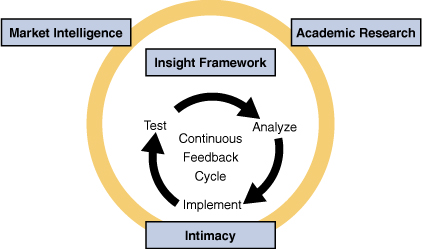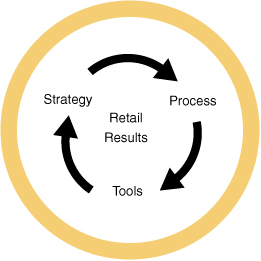Introduction
Intimacy is the only sustainable path to consistent results.
The marketing world is in the midst of unprecedented changes that shatter the core of all the traditional, “proven” marketing models. The changes retailers and marketers confront extend far beyond the well-documented implosion of traditional media to include both consumers and retailers. Quite simply, every part of the conventional world is in flux with new models yet to be defined. Increasingly, it appears that Moore’s Law, which postulates that processing capacity will double every two years, can easily be applied to marketing to describe the speed of change and innovation. Achieving and maintaining, not just a connection, but true intimacy with the shopper, is the new necessity.
Why do we say shopper intimacy?
Today, although more attention than ever is focused on understanding what motivates the shopper, the conversation generally revolves around, shopper insights. We suggest that having insights into your shoppers buying habits is not enough.
For true success, you need intimacy—understanding what your shopper does and is going to do in this shopping environment and why. With this knowledge, you can better tailor and deliver both your message and offer to encourage trial and long-term brand loyalty.
Shopper intimacy comes from knowing how shoppers actually behave at retail as revealed in the extensive in-store research, applying psychology and cognitive behavior studies to these observations to understand the motivation for these behaviors, and then rigorously applying these learnings throughout the organization in a formal program we call the Retail Ecosystem Analytics Process (REAP).
Three macro-trends with profound implications for retailers and marketers drive the current market shifts—major demographic shifts, media changes, and the maturation of dominant retail concepts. Together these trends have initiated unprecedented and ever-accelerating change that affects all of us.
Demographically, we live in an older society with more concentrated wealth and smaller households that increasingly do not meet the definition of a traditional family. Additionally, a series of dramatic shifts between the older and younger generations can be seen in the growing multiculturalism of society and the rapid adoption of new technologies by the youngest members of society. The generations meet in their increasing consumption of services versus goods, but diverge in their understanding of the personal implications of technology.
Together these trends explode the now antiquated notion of a mass market and destroy the utility of measuring efforts to reach consumers in terms of cost per thousand. The rapid adoption of transformative technologies amplifies the demographic trends so that new consumers increasingly self-define the groups with which they identify and assert control over the information they consume and choices they make. The new consumers expect to find any product in the place they want to purchase it. They expect universal quality and low costs. They want products and shopping venues that speak to them as individuals and members of the groups they create and select.
These demographic trends extend to traditional media decimated by the effects of these shifts. The net is the delivery of fewer consumers for a constantly rising cost through a business model that may not be sustainable as advertisers demand accountability for all expenditures. This focus on accountability extends to every element of the marketing plan and means that marketers need to know what their shoppers had the opportunity to see, what they actually saw, and whether that interaction culminated in a sale.
In the retail world, the dominant shopping formats have matured and expanded across the developed geographies so that the metric for developed markets is now same-store sales, and store count growth is predominantly driven by expansion in developing economies. The focus on same-store sales performance results in assortment expansion into high-traffic categories to spur more store visits and the growth of private labels to capture higher margins per transaction. As with media, each investment is tested against its return to the bottom line.
The inter-related strands of shopper diversification and empowerment, mass media implosion, and retail maturation converging at a time of great economic distress creates a major inflection point that shifts more attention to the marketing activity at retail.
Unfortunately, although leading practitioners recognize these shifts, they also acknowledge that their organizations lack crucial pieces of understanding in the areas that are most critical to driving greater success in the marketing at retail arena. These leading practitioners agree on an ideal model in which marketing research and insights generated from a steady stream of measurement data and performance metrics for retail lead to the development and execution of well-defined strategies that engage shoppers, close sales, and ultimately create the brand loyalty that underpins brand equity (see Figure I.1). At the same time, they ruefully admit that they are unable to effectively execute against it.
Figure I.1 REAP Design Process

This book seeks to provide the data, tools, and methodology that provide the missing links for implementing this model and increasing retail success.
Our shopper intimacy program promises to bring together the worlds of retailers and marketers in the place where they meet with the shopper. Intimacy drives consistent retail results, and to achieve intimacy, we take a journey in five phases:
• Market intelligence on shopper behavior at retail
• Behavioral research to unlock the foundational precepts driving shopping behavior in store
• A process for integrating this data to achieve intimacy with the shopper
• Tools for implementing strategies driven by this intimacy
• New measurement techniques for tracking success
Collectively, the industry has spent millions of dollars on research instore to
• Quantify the traffic in the store
• Track the marketing activity taking place at retail
• Measure the impact of differential executions in different channels
• Track shoppers interaction with marketing material and its eventual conversion into sales
If shopper intimacy provides the path to consistent results, the knowledge gained from research at retail provides the necessary information base for its initiation. We dissect the recent market intelligence with an eye to drawing lessons about what works at retail by measuring shoppers’ behavior in stores. We then move to a discussion of key academic research into shopper behavior, breaking our review into the biologic, cognitive, logical, and social foundations of human behavior in the retail environment. By applying the knowledge developed by researchers in the lab with the intelligence gathered in-store, we establish a contextual framework through which we can isolate key variables to create insights. By testing and verifying insights within a formal process and setting up a continuous feedback cycle, we create intimacy with the shoppers as we answer the fundamental question of what shoppers want (see Figure I.2).
Figure I.2 Shopper Analysis - Integration

As with any program, strategy without execution results in complete failure. To ensure that our hard-won intimacy drives results, we developed a Retail Ecosystem Analytics Process (REAP) that extends strategic consideration to all the key players in creating retail success. Combined with the tools developed from our analyses of successful programs, we provide a practical guide to generating ongoing sales success (see Figure I.3).

The payoff is the information, tools, and methodology to deliver the following:
• Better understanding of the marketing at retail environment
• Improved retail results based on insights that lead to shopper intimacy
• Establishment of a more accurate medium valuation
• Proper integration of retail into marketing mix
John Wanamaker, the much-admired 19th-century merchant, famously said, “I know half the money I spend on advertising is wasted…. I just don’t know which half.” Our studies help lift this veil of mystery to understand what works and why, so we can better predict what will work in the future to drive increased marketing investment efficiency.
